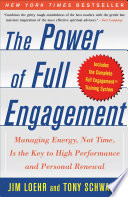

The authors, Jim Loehr and Tony Schwartz, argue that managing energy is far more effective than merely managing time. In today’s fast-paced world, individuals often find themselves overwhelmed by the sheer volume of tasks and responsibilities. The book emphasizes that energy is a finite resource, and its renewal is essential for sustained performance. By focusing on energy management, individuals can enhance their productivity and well-being. The authors propose a four-part energy model: physical, emotional, mental, and spiritual energy. Each type of energy influences performance, and by optimizing them, individuals can achieve higher levels of engagement in both their personal and professional lives. For instance, incorporating physical exercise into daily routines can boost physical energy, while practicing mindfulness can enhance emotional energy. This holistic approach encourages readers to consider their overall energy levels and to implement strategies that foster renewal and balance across all areas of their lives.
Continue readingRituals play a crucial role in enhancing performance and engagement. The book discusses how establishing specific rituals can help individuals create a sense of structure and predictability in their lives. These rituals can be as simple as morning routines or as complex as strategic planning sessions. The authors explain that rituals serve to anchor individuals, providing them with a framework that facilitates focus and discipline. By integrating rituals into daily life, individuals can better manage their energy and maintain high levels of engagement. The book offers examples of successful individuals who utilize rituals to enhance their performance, demonstrating that the consistency of these practices leads to improved outcomes. Moreover, rituals can help in transitioning between different tasks or roles, allowing individuals to mentally prepare for what’s next. This concept encourages readers to identify and cultivate their own rituals that align with their values and goals.
Continue readingFinding and connecting with one’s purpose is a central theme in 'The Power of Full Engagement'. The authors argue that individuals who have a clear sense of purpose are more likely to be fully engaged in their work and personal lives. Purpose acts as a motivating force, driving individuals to invest their energy into activities that resonate with their values. The book provides insights into how individuals can discover their purpose through self-reflection and exploration of their passions. Once purpose is identified, it becomes a guiding principle that influences decision-making and prioritization of tasks. The authors emphasize that purpose not only enhances engagement but also contributes to overall well-being and satisfaction. This idea encourages readers to reflect on what truly matters to them and to align their actions with their purpose, ultimately leading to a more fulfilling life.
Continue readingThe authors emphasize the importance of balancing energy expenditure with energy renewal. In a world that often glorifies busyness and constant activity, it is easy to overlook the need for recovery and rest. The book discusses the concept of oscillation, which involves alternating between periods of intense focus and periods of recovery. This balance is crucial for maintaining high levels of engagement and preventing burnout. The authors provide practical strategies for incorporating renewal into daily routines, such as taking breaks, engaging in leisure activities, and ensuring adequate sleep. By prioritizing renewal, individuals can sustain their energy levels and enhance their overall performance. This idea challenges the traditional notion of productivity, suggesting that true productivity comes from knowing when to push hard and when to step back for recovery.
Continue readingAccountability is a powerful motivator that can significantly enhance engagement and performance. The authors discuss how having someone to hold you accountable can increase commitment to goals and actions. This can take the form of a coach, mentor, or even a peer group. The book emphasizes the importance of creating a supportive environment where individuals can share their goals and progress with others. By establishing accountability partnerships, individuals are more likely to stay on track and maintain their commitment to personal and professional development. The authors provide examples of how accountability has helped individuals achieve their goals, reinforcing the idea that social support is a key factor in sustaining engagement. This concept encourages readers to seek out accountability mechanisms in their own lives, fostering a culture of mutual support and encouragement.
Continue readingThe book encourages readers to embrace challenges as opportunities for growth. The authors argue that stepping outside of one’s comfort zone is essential for developing resilience and enhancing engagement. By facing challenges head-on, individuals can cultivate a growth mindset, which fosters a belief in one’s ability to improve and succeed. The book provides strategies for reframing challenges, viewing them as learning experiences rather than obstacles. This perspective shift can lead to increased motivation and a willingness to take risks. The authors highlight that engagement often flourishes in environments that encourage experimentation and learning from failure. This idea inspires readers to view challenges as integral to their personal and professional journeys, ultimately leading to greater fulfillment and achievement.
Continue readingThe environment in which individuals operate significantly influences their ability to engage fully. The authors discuss the importance of cultivating a supportive environment that fosters engagement and well-being. This includes both physical and social aspects of the environment. For instance, a well-designed workspace can enhance focus and productivity, while a positive social network can provide encouragement and motivation. The book emphasizes the need to assess and modify one’s environment to better support engagement. This might involve decluttering physical spaces, seeking out positive relationships, or creating routines that promote focus and energy renewal. By intentionally designing their environments, individuals can create conditions that enhance their ability to fully engage in their work and personal lives.
Continue reading